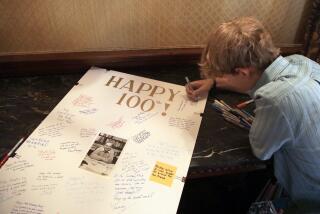Summer Vocation : Teen-Ager Balances Youth Pursuits With Scientific Research at Caltech
- Share via
Tessa Walters was only 14 the summer she worked at Caltech, doing research on the virus that causes AIDS.
She was only 15 when she discovered an amino acid compound that her mentor scientist at Caltech says could eventually help prevent high blood pressure.
Now 16, the San Gabriel High School student recently swept first place in biology competitions in county, state, national and international science fairs. She also won a $10,000 scholarship and an award from the California Assn. of Professional Scientists.
Tessa, who wears her blond hair long, also plays varsity volleyball and the violin and was junior class president this year. She sprinkles her scientific discussion about peptides, amino acids and the genetic material RNA with standard teen-age terms.
As she sits in a coffee shop explaining how the protein-based drug she discovered inhibits one of the enzymes that contributes to high blood pressure, Tessa’s face takes on a glow that has nothing to do with the strawberry shortcake she’s eating.
“It’s neat,” she says. “It turns out these inhibitors are found naturally in the snake venom of the Brazilian pit viper,” she says.
Tessa’s supervisor at Caltech, visiting molecular biologist Stephen Kent from Bond University in Australia, told the teen-ager she would receive a percentage of the profit if a drug is ever marketed.
While additional research will be necessary first, her work impressed Kent enough that he wrote:
“Tessa Walters . . . embodies all the attitudes, dedication, manipulative skill, patience and resourcefulness that are the hallmarks of the great experimentalists such as Fred Sanger,” the Nobel Prize-winning biochemist who did pioneering work with insulin and developed a method to determine the chemical structure of DNA.
This summer, Tessa will conduct research on RNA-splicing with a team of postdoctoral fellows and graduate students.
School officials say she is one of a handful of gifted high-school students who have done research at Caltech under the aegis of mentor scientists.
The teen-ager’s current project involves creating a collection of 4,000 temperature-sensitive yeast mutants and analyzing them for defects in messenger RNA. By studying defective RNA, scientists can learn more about how normal RNA operates.
Tessa is quick to credit the support of several Caltech professors who believed in her from the beginning.
“I thought they would put me to work washing test tubes,” she recalls.
Tessa still has another year at San Gabriel High. She already has devoured all the math and science courses there and will take freshman core classes at Caltech this fall.
Tessa’s father is a jazz musician who plays the trombone and has written a symphony. Her mother, who teaches remedial math at San Gabriel High, whetted Tessa’s natural curiosity in math and science by enrolling her in summer classes at the Los Angeles Museum of Science and Industry.
While still in grade school, Tessa tinkered in the back yard with hydroponics, or growing plants without soil, asking herself “What if?” and then setting up experiments to answer her own questions.
At 12, she cooked up a batch of acid rain for a local science fair and poured it on building materials to test the reactions. The following year, she tackled ground water pollution, simulating the layers of earth under 20 San Fernando Valley heavy-industry firms and analyzing how long it would take for the chemicals they produced to percolate through the dirt, sand and gravel layers and leach into underground water sources.
One of her teachers, whose husband taught at Caltech, helped her get an introduction to Kent.
Kent gave her magazine articles on synthesizing peptides, the amino acid compounds that form one of the building blocks of the human body.
Tessa went assiduously to work, and from then on, Kent took her seriously. “He taught me important research techniques,” Tessa says.
Later, she worked with a team doing research with HIV-1, the human immunodeficiency virus that causes AIDS, to define the virus’ structure so scientists can better see what role it plays in breaking down the body’s immune system.
The work was so all-encompassing that Tessa began leading a double life: At school she was a typical teen-ager, playing volleyball and hurrying through her homework. Then, her mother would drive her to Caltech in Pasadena, where she averaged 30 hours of work a week, sometimes staying until 1 a.m.
Soon, Tessa will have to start thinking about her application to Harvard, where she hopes to be accepted as a double major in chemistry and astrophysics. Gone are her original hopes of becoming a neurosurgeon. Thanks to her work at Caltech, she hopes to become a research scientist and win a place on board a future space shuttle mission.






